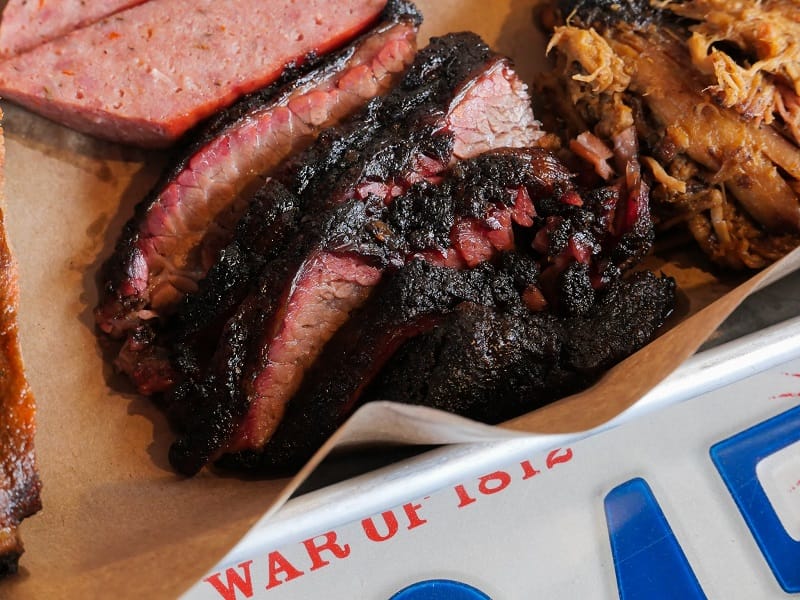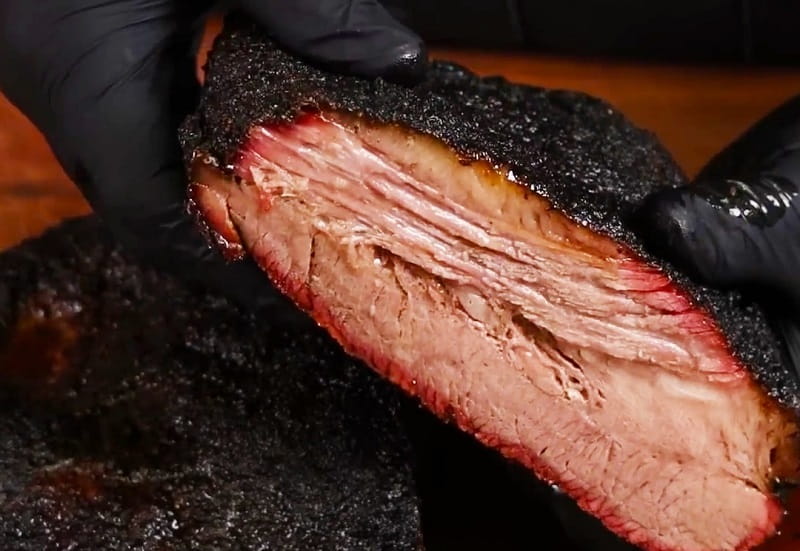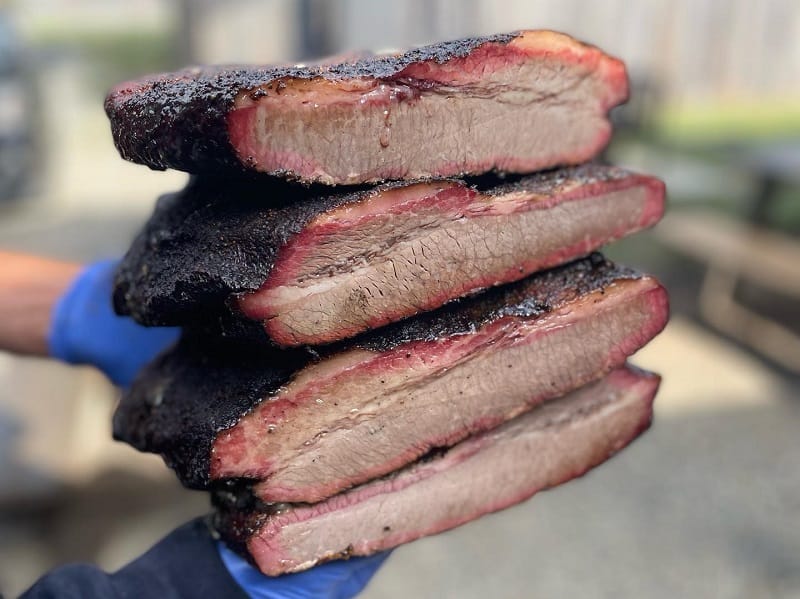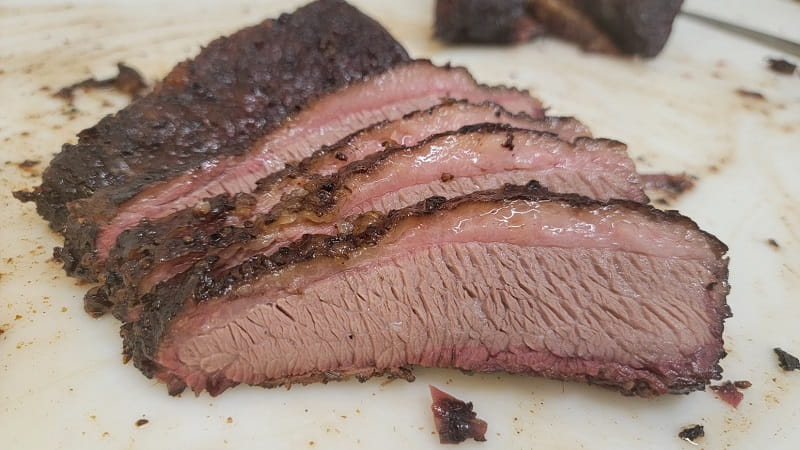Cooking a delicious brisket can be daunting, but the reward is worth it when you enjoy the tender beef. One of the most important parts of any good brisket recipe is allowing adequate time for the meat to rest after cooking. But how long should you let your brisket rest? This article will explore the importance of resting your brisket and provide tips on how long to let brisket rest before serving.
Why Do You Need To Let Your Brisket Rest?

Resting the brisket is crucial in preparing a delicious and tender piece of meat. When you let the brisket rest after cooking it, you give the juices a chance to reabsorb into the meat, resulting in a more intense flavor. This is why it’s important to let your brisket rest before serving it.
But why is it so important to let your brisket rest? Well, there are several reasons.
The first reason is that the meat will become more tender. When the juices have time to reabsorb into the meat, it produces a more tender piece of meat. This makes it easier to cut and chew and helps the flavors develop more fully.
The second reason is that it helps to keep the meat juicy. When you don’t let the brisket rest, the juices released during the cooking process escape into the air. This can lead to dry, overcooked meat. Letting the brisket rest allows the juices to redistribute throughout the meat, ensuring it remains juicy and tender.
Finally, it helps to preserve the meat’s flavor. When the juices are given time to reabsorb into the meat, the flavors that develop during cooking become even more intense. This intensifying flavor is what makes a delicious piece of brisket.
Is There A Certain Temperature Range I Should Keep My Brisket In While It Is Resting?
It is important to remember that cooked brisket must be held above 140°F in order to remain safe to eat. Therefore, if you want to let your brisket rest for a few hours, it is best to place it in a cooler to maintain the temperature between 140°F and 200°F.
You should also try to bring the temperature down from 200°F to 140°F over 4 hours. If there is still some resistance in the brisket at 205°F, drop the temperature of the holding oven to 145°F and place the brisket inside. Remember, you want the brisket to remain safe and delicious during its resting period!
How Long To Let Brisket Rest?
When smoking your brisket, let the meat rest for at least two hours before slicing. The ideal rest time for brisket is two to six hours, depending on the size of the brisket. For best results, aim for an internal temperature of 145°F.
During this resting period, you should place the brisket in a slightly warmer place in your kitchen. Resting your brisket allows the juices to settle and distribute evenly throughout the meat, ensuring that each slice is tender and flavorful. Following this simple tip will help you get the most out of your smoked brisket and make it even more delicious.
Are There Any Benefits To Allowing A Longer Resting Time For A Brisket, Or Is 15-20 Minutes Sufficient?
When it comes to brisket, the key to achieving the most tender, flavorful, and juicy results lies in how long you allow it to rest. Even the most experienced pitmasters may disagree on the exact resting time for a brisket, with some swearing by 15-20 minutes and others advocating for a longer resting time. So, are there any benefits to allowing a longer resting time for brisket, or is 15-20 minutes sufficient?
When you take a brisket off the smoker, the meat is still in a very fragile state. The meat continues to cook during the resting period, and its internal temperature rises. The longer you allow the brisket to rest, the more evenly cooked and tender it will be. If you cut into a brisket that hasn’t rested for long enough, you may end up with an unevenly cooked, dry, and chewy product.
Another benefit of allowing your brisket to rest for longer is that it helps retain the juices inside. As your brisket rests, the juices redistribute throughout the meat, making it more tender and flavorful. If you cut into the brisket before it can rest, all the juices will escape, causing it to dry out.
Finally, allowing a brisket to rest helps ensure its flavors are fully developed. As the meat cools, the flavors have time to blend and intensify. Without the resting period, the flavors will be less balanced, and the texture won’t be as tender.
Allowing the brisket to rest for 1-6 hours, the connective tissue continues to break down, and fat renders evenly, resulting in an even more tender and flavorful piece of meat.
Resting a brisket also allows natural juices to redistribute throughout the meat, making it extra juicy when served. So, while 15-20 minutes may be sufficient for some cuts of meat, allowing your brisket to rest for 1-6 hours can benefit your dish’s overall taste and texture.
What Happens If I Don’t Rest My Brisket?

When you rest a brisket, you allow the juices to redistribute throughout the meat, which helps keep the brisket moist and flavorful. If you don’t rest the brisket, the juices will seep onto the cutting board instead of staying inside the meat. This means that when you cut into the brisket, you’ll be left with dry, tough, and unappetizing pieces of meat.
Another issue with not resting a brisket is that it won’t cook evenly. If you don’t let the brisket rest, the outside of the meat will be overcooked while the inside is still undercooked. This can lead to a less-than-pleasant eating experience.
Finally, it’s important to note that resting time is just as important as cooking time. If you don’t allow the brisket to rest, it won’t have enough time to reach its full flavor potential. While you may be tempted to rush the cooking process, it’s important to remember that a good, long rest will ensure that your brisket is cooked to perfection.
How to Rest Brisket
Now that you know how long to let Brisket rest, let’s discuss how to do it properly. The process is fairly simple, but you should follow key steps to ensure a juicy, flavorful final product.
Here’s what you need to know:
1. Resting in a cooler
This is one of the most popular methods for resting brisket. Using a cooler, you can maintain an ideal temperature of 140-150 degrees Fahrenheit for up to 8 hours. To do this, you’ll need to place the brisket in a well-insulated cooler with a damp towel. Next, add boiling water to the cooler to create a moist environment. Finally, seal the cooler and let the brisket rest for the desired time.
2. Resting in a steam cabinet
If you don’t have access to a Cambro, you can use a steam cabinet to rest your brisket. The steam cabinet will allow the meat to rest in a consistent temperature environment of 140-150 degrees Fahrenheit. To do this, place the brisket in the steam cabinet and set the temperature to the desired level. Let the brisket rest for 4-8 hours.
3. Resting in a Cambro
A Cambro is a temperature-controlled box that helps maintain a consistent temperature. This is the preferred method for restaurants, allowing the brisket to rest in a consistent temperature environment. To use a Cambro, place the brisket in the box and seal it. Next, set the temperature to 140-150 degrees Fahrenheit. Let the brisket rest in the Cambro for 4-8 hours.
4. Room temperature rest
Finally, you can also rest your brisket at room temperature. This is the least desirable method, as room temperature is inconsistent and can lead to uneven cooking. To do this, place the brisket in a shallow baking dish and lightly cover it with foil. Let the brisket rest for 1-2 hours.
Should I Cover The Brisket While It Is Resting?
No, when it’s time to rest your brisket, don’t cover it. While resting is important after smoking a brisket, wrapping the meat will cause it to continue cooking and spoil the flavor. Instead, unwrap your brisket and allow it to rest at room temperature when the cooking is done. Depending on the size of the brisket, let it rest for between two to six hours, but at least an hour. This will give the meat time to cool down and let the juices redistribute before you serve it.
How Long Can A Brisket Rest Before It Starts To Dry Out?
Typically, a brisket can rest for up to two hours before it starts to dry out. However, if you can keep the brisket in an insulated container or wrap it in aluminum foil, it can last up to four hours before it starts to dry out. To ensure that your brisket is as moist and tender as possible, it is best to serve it as soon as possible after it has finished cooking.
How to Know When the Brisket is Ready?

The first step is to check the internal temperature of the brisket. An instant-read thermometer is the best tool for this job. Insert the thermometer into the thickest part of the brisket and ensure it’s not touching any bone. The internal temperature should be between 190-205F (88-96C) for a fully cooked brisket.
Another way to tell if your brisket is ready is to press on it with your finger or tongs. If it feels tender, it’s probably ready. If the meat feels more challenging than you’d like, it’s likely not done yet.
Finally, the color of the meat can also be an indication of doneness. Cooked brisket should have a deep mahogany color with a dark crust. If the brisket is still pale, it must be cooked longer.
By following these simple steps, you can quickly tell when your brisket is ready to enjoy. While it might take some trial and error to get the perfect brisket, with some practice, you’ll be well on your way to becoming the BBQ master you’ve always wanted to be!
What Are Some Common Mistakes To Avoid When Letting A Brisket Rest?
There are some common mistakes that you need to avoid to ensure that your brisket is as delicious as possible.
One of the most common mistakes when letting a brisket rest is not allowing it to rest long enough. The longer the brisket is allowed to rest, the more the flavors and juices will be locked in. In general, it’s best to let the brisket rest for at least an hour after it’s finished cooking. This will ensure all the flavors are brought out, and the brisket is as juicy as possible.
Another mistake people make is not allowing the brisket to rest in a warm environment. If you let your brisket rest in a cold environment, the juices and flavors will be lost, leading to a dry and tough piece of meat. If possible, let your brisket rest in a warm environment, such as an oven with the heat turned off or on the lowest setting.
Additionally, you should avoid cutting into the brisket too soon. Cutting into the brisket before it has had a chance to rest will cause the juices to run out, resulting in a dry and flavorless piece of meat. It’s best to wait at least an hour before cutting into the brisket; this will ensure that all flavors and juiciness are locked in.
Finally, you should avoid letting your brisket rest for too long. If you allow your brisket rest for too long, the flavors and juiciness will dissipate, and the meat will become dry and tough. The ideal time to let a brisket rest is between one and two hours.
Avoiding these common mistakes ensures that your brisket is as juicy and flavorful as possible. So make sure to give your brisket the time it needs to rest before you cut into it and enjoy the delicious results.
You also like:
- How Long To Smoke Ribs At 250
- What Part Of The Cow Is Brisket
- How To Keep Brisket Warm
- Can You Overcook Brisket
Tips for Perfectly Brisket
1. Start With The Right Cut
The first step to making a perfectly resting brisket is to start with the right cut. Look for a brisket with a good amount of fat marbling, ensuring the meat stays juicy and tender throughout the cooking process.
2. Brine Before You Cook
Brining is an important part of the process when it comes to making a perfectly resting brisket. Brining helps to make the meat more tender and flavorful, as well as helping to lock in the moisture.
3. Choose Your Cooking Method
Whether you’re barbecuing or slow cooking, your cooking method will affect the result of your brisket. For slow cooking, you’ll want to cook it at a low temperature for longer. For barbecuing, you’ll want to cook it at a higher temperature for a shorter period.
4. Don’t Overcook
It’s important to make sure you don’t overcook your brisket. Overcooking can cause the meat to become tough and dry, so keep an eye on the temperature and the cooking time to ensure you don’t go too far.
5. Let It Rest
Once your brisket is cooked through, it’s important to let it rest before serving. This will help to redistribute the juices and let the flavors settle, resulting in a perfectly juicy, tender brisket.
How Can I Tell If My Brisket Is Done Resting And Ready To Slice?
The best way to tell if your brisket is done resting is by using a meat thermometer. Insert the probe into the thickest part of the brisket and keep an eye on the temperature. When the internal temperature reaches between 195°F and 205°F, your brisket is ready to be served.
In addition to using a thermometer, you can also check the texture of your brisket. If it’s tender and easy to slice, then it’s done.
If you’re using a smoker or a slow cooker, you can also tell when your brisket is done by checking the amount of smoke. If the smoke is diminishing, then your brisket is likely finished.
Finally, you can also use the poke test. Gently press your finger into the brisket and then release it. If the indentation slowly fills back in, then your brisket is done.
Is There Anything Special I Should Do Once The Resting Time Is Over, And I’m Ready To Slice Into The Brisket?
The answer is yes! Before you even begin to slice into the brisket, you’ll want to make sure you have a sharp knife ready. A sharp knife allows you to slice the brisket precisely, which not only looks better but also ensures that your brisket is cooked evenly. You’ll also want to ensure that you have a cutting board ready. Cutting boards provide a surface that’s easy to work with and can help prevent your knife from slipping and causing an accident.
When you’re ready to start slicing, always cut against the grain. This means that instead of cutting along the muscle fibers of the brisket, you should cut across them. Doing this will help ensure that your meat is tender and juicy. You’ll also want to ensure you’re cutting in a single, smooth motion. This will help your brisket retain its juices and prevent the meat from drying.
When you’re done slicing, you’ll want to ensure that you’re serving the brisket properly. Make sure you’re cutting your brisket into slices about ¼ inch thick, as this is the perfect thickness for a juicy and flavorful brisket. You’ll also want to ensure that you’re serving the brisket on a platter or large cutting board, as this will help keep it warm, and the juices will seep into the board.
FAQs About How Long To Let Brisket Rest
Does The Size Of The Brisket Affect How Long It Needs To Rest?
The size of your brisket does affect how long it needs to rest. Generally, smaller briskets take less time to rest than larger ones.
Does Resting Brisket Soften The Bark?

Resting your brisket is a great way to keep the meat moist and juicy, however, it can also soften the bark. That said, it’s a small price to keep your brisket juicy. Wrapping your brisket up in either foil or butcher paper can help reduce the softening of the bark. You can even let your smoked brisket rest in a cooler if you want to. Just remember that resting your brisket will soften the bark, but it’s worth it for that delicious juicy meat!
Can I Let My Brisket Rest Overnight If I’m Not Ready To Serve It Right Away?
No, you shouldn’t rest a brisket overnight, regardless of size. For one thing, the meat will certainly go dry, and it isn’t safe to do so. Resting brisket will keep the meat moist, so if you pull it off the pit and slice it immediately, that moisture has not been reabsorbed back into the meat.
When resting brisket, aim for a window of 1 to 4 hours; you might get away with shorter resting times if the cut is small, but for larger cuts, aim for closer to 4 hours. You can remove the brisket from the oven after a minimum of 2 hours and serve it. If you are not ready to serve it immediately, wrap your brisket in butcher paper and store it in a cooler with plenty of ice packs. With this method, you should be able to rest your brisket for up to 8 hours.
Is It Better To Wrap The Rested Brisket In Foil Or Plastic Wrap For Storage, Or Can I Leave It Uncovered On The Countertop?
Wrapping your rested brisket in foil or plastic wrap is a great way to store it later. The foil will help keep the moisture in and protect the meat from outside contaminants. Plastic wrap is also an acceptable option, as it will help keep the meat moist and protected.
However, if you plan on consuming the brisket within a few hours of taking it off the smoker, you can leave it uncovered on the countertop. This is generally not recommended for longer periods of time, as the temperature and humidity of your kitchen can cause the meat to dry out or spoil.
Does The Type Of Meat (Beef, Pork, Etc.) Affect How Long You Need To Let Your Brisket Rest Before Slicing?
Yes, the type of meat you are cooking affects how long you need to let your brisket rest before slicing. For example, if you cook a steak, you only need to let it rest for 10 to 15 minutes. On the other hand, brisket is a much bigger cut of meat and needs to be rested for between one hour to six hours, depending on the size of the cut.
This is because brisket is a tough cut of meat and needs time to rest to allow the juices to redistribute. Meanwhile, small cuts of meat like pork chops only need to be rested for a few minutes.
Therefore, when deciding how long you should let your brisket rest before slicing, it’s important to consider the type of meat you’re working with.
Does Resting Prevent Dry Brisket?
Yes, resting does help prevent dry brisket. When brisket is cooked, the proteins in the meat break down and expel moisture. Allowing the brisket to rest after it has been cooked allows the meat to reabsorb that moisture, resulting in a juicier, more flavorful cut of beef. When the brisket is rested, the juices redistribute throughout the brisket and help to keep the meat tender and moist.
If My Guests Are Running Late And My Rested Brisket Has Been Sitting Out For Longer Than Recommended, Is It Safe To Eat, Or Should I Start Over With Another One?
Is It Important To Wrap The Brisket In Foil Before Resting?
It is important to wrap the brisket in foil before resting, as this helps the meat cool down and redistribute the juices. Wrapping it in foil will also prevent the bark from getting soggy.
Should I Check The Internal Temperature Of The Brisket Before Or After Resting It?
The answer is that you should check the brisket’s internal temperature before resting it. This will help you ensure that the brisket is cooked to the proper temperature and that it is safe to eat. When the brisket’s internal temperature is taken before resting, it will help you know how long it needs to rest to reach the desired temperature. Resting will help the brisket retain its moisture and prevent it from drying.
Can I Refrigerate My Smoked Brisket Before Or After Letting It Rest?
Yes, you can refrigerate your smoked brisket before or after letting it rest. First, take the brisket off the heat source and remove any foil or butcher paper. The brisket should rest until it reaches a minimum safe holding temperature of 140°F. It’s best to let the brisket rest for at least an hour and cool down to at least 140°F before storing it in the fridge. This will help keep maximum flavor and moisture in the meat.
Once cooled, wrap the brisket and store it in the fridge or freezer for up to four days. Putting the brisket in the refrigerator prior to slicing can make the process go more smoothly as it will be easier to carve it into thin slices this way.
Conclusion
When it comes to smoking and barbecuing your brisket, patience is key. The key to perfect brisket is to let it rest for the appropriate amount of time. This will ensure that your brisket is tender and juicy, and the flavor will be out of this world.
So, the next time you’re barbecuing a brisket, give it the proper rest. This will make all the difference in the result and guarantee that your brisket is the best it can be.
Now that you know how long to let brisket rest, nothing stops you from trying this recipe today!

Hey readers! Chip Holland here, and I’m a Manager of this website. My passion for writing about it only matches my passion for BBQ. Follow my blog for mouth-watering recipes, tips, and tricks for the perfect smoke, grill, and BBQ. I’m sure you won’t be disappointed!
